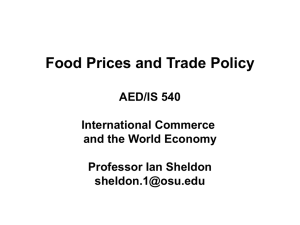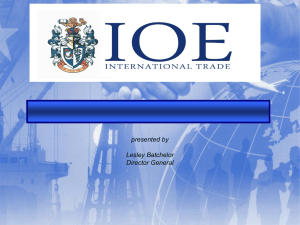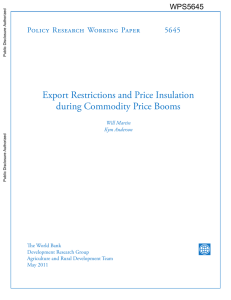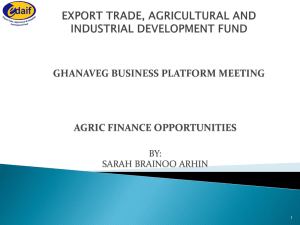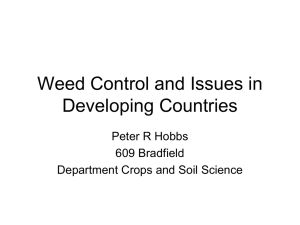Food Price Volatility and Food Security
advertisement
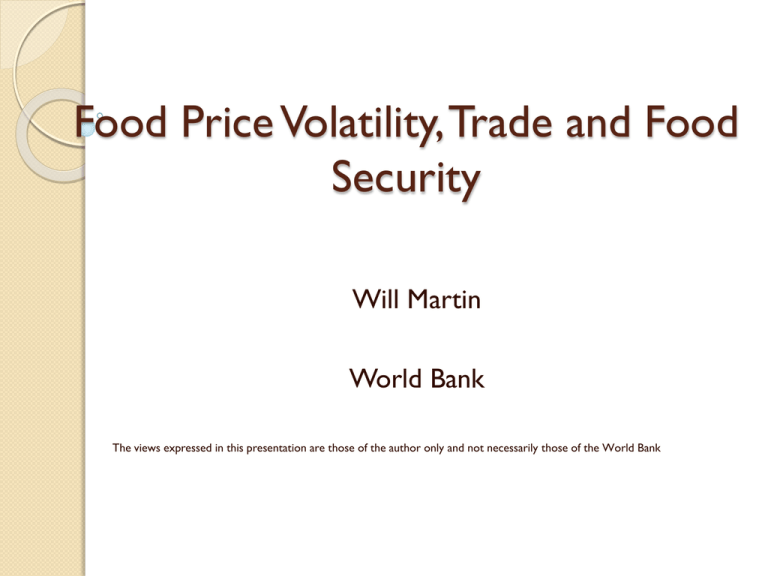
Food Price Volatility, Trade and Food Security Will Martin World Bank The views expressed in this presentation are those of the author only and not necessarily those of the World Bank Issues Why do high and volatile prices matter? What makes sense for individual countries? The collective action problem Potential policies to mitigate the problem Food price volatility Shocks to output are the major source ◦ These may get worse with global warming Shocks to demand from--for instance--biofuels, may also contribute Globalization can help reduce price volatility by diversifying sources of supply ◦ Likely to be part of the solution rather than a problem Impacts depend on stock levels If stocks are normal, adverse shocks can be absorbed by stock reduction Key problems arise when stocks are low ◦ Reducing demand in line with supply requires large increases in price Prices spend long periods in the doldrums punctuated by short but intense price spikes Real wheat prices Source: USDA. Deflated using U.S. CPI Impacts of food prices on the poor Poorest spend 75% of income on staple foods 3/4 of poor people are rural & earn most of their income from farming ◦ Poor farmers don’t gain much from higher prices Many are net buyers of staple foods ◦ Little opportunity to increase output in response to higher prices Net impacts on poverty? ◦ Are the gains to poor net sellers outweighed by the losses to poor net buyers? 6 Jan-00 May-00 Sep-00 Jan-01 May-01 Sep-01 Jan-02 May-02 Sep-02 Jan-03 May-03 Sep-03 Jan-04 May-04 Sep-04 Jan-05 May-05 Sep-05 Jan-06 May-06 Sep-06 Jan-07 May-07 Sep-07 Jan-08 May-08 Sep-08 Jan-09 May-09 Sep-09 Jan-10 May-10 Sep-10 Jan-11 Rice & wheat prices, $US 1000 900 800 700 600 500 Rice 400 Wheat 300 200 100 0 Poverty Impacts: 2005-8 price rise Used data on household production, purchases & sales of major staple foods and sales of unskilled labor Household survey data for ten low-income country-periods ◦ Bolivia, Cambodia, Madagascar, Malawi, Nicaragua, Pakistan, Peru,Vietnam (98,04), Zambia Used World Bank $1 per day poverty rates Estimated that the 2005-8 price rises put 100 million into poverty 8 2010-11 price surge Primarily June to December 2011 ◦ Wheat, maize, many other commodities ◦ But fortunately not rice Much less likely that wages have responded Used detailed data on the extent of passthrough into domestic prices Data on 28 countries & 38 commodities Estimate that 44 million have been pushed below the $1.25/day poverty line ◦ 68 million entering poverty; 24m escaping 9 Poverty impacts by country, % pt 4 3 2 1 0 -1 -2 What should poor countries do? An attractive policy option is to: ◦ Restrict exports when world prices are high Lower tariffs or pay import subsidies if an importer Countries are strongly countercyclical with their trade policies ◦ Many raise protection and/or pay export subsidies when prices are low Historically both industrial & developing countries have insulated in this way South Asia Rice: Nominal rate of assistance vs World Price: Correlation: -0.754 600 30 20 500 10 300 -20 -30 200 -40 -50 100 Pw S Asia 2004 2002 2000 1998 1996 1994 1992 1990 1988 1986 1984 1982 1980 1978 1976 1974 - 1972 -60 1970 USD -10 -70 NRA % 0 400 A potential spiral? Higher world prices More export restrictions Higher world prices Export restrictions Import barrier reductions A collective action problem If everyone attempts to reduce the impact of world price increases The policy appears to be a success ◦ “Domestic prices rose less than world prices” But it is collectively completely ineffective ◦ The world price increases one for one with attempts to lower domestic prices Like the grandstand problem When everyone in a crowd stands up to get a better view ◦ No one does if all are the same height ◦ And all those of below-average height lose out But unilateral refusal to participate doesn’t solve the problem ◦ If I don’t stand up, I get a terrible view! Unfortunately, insulation against staple food price changes can have more serious consequences Analyze price rises of 1973-4 & 2005-8 Use World Bank data on distortions to agricultural incentives ◦ Data for 75 countries ◦ Update to 2008 Assess the impacts of rising export barriers, declining import barriers, on world prices Estimated impacts on world prices Impact of Δ Protn Share due to Δ Protn % % Rice 2005-8 46 45 Wheat 2005-8 28 30 Insulation in rich & poor countries Developed countries have traditionally used insulating policies ◦ Very strongly in 72-4 & 84-86, ◦ But much less in 06-08 60 50 40 30 20 10 Wheat HICs Wheat DCs 0 WTO disciplines on insulation? ◦ eg ban on variable levies? 1972-74 -10 -20 -30 -40 -50 1984-86 2005-08 2008 surge, rice prices 250 Producer Price Asia Producer Price Africa Producer Price Latin America 200 International Reference Price 150 100 2006 50 0 2007 2008 2009 2010 2008 surge, wheat prices 250 Producer Price Asia Producer Price Africa Producer Price Latin America 200 International Reference Price 150 100 2006 50 0 2007 2008 2009 2010 Insulation policies Clearly, insulation policies are much less effective than they appear to individual countries ◦ Redistribute, rather than reduce, domestic price volatility For large countries, such as China, India and Vietnam, the effect is very direct ◦ Export restrictions raise world prices, reducing the effectiveness of the policy For all countries, the collective action problem remains Domestic policy options: poor countries Protecting the poorest is most important ◦ Best to focus on safety-nets for the poorest rather than trade barriers that reduce incentives to produce, and for the better-off to reduce consumption May require small, targetted stocks Help producers in poor countries ◦ Improved technology can help raise incomes and lower poverty in the longer term ◦ Improved access to risk management tools Domestic policy options: rich countries Protecting the poorest is important ◦ Safety-net policies better than price distortions Help producers improve technology ◦ Improved access to risk management tools Re-examine biofuel policies? ◦ Do they make environmental sense? ◦ Are the resulting price rises sustainable? ◦ Mandates inflexible when food supplies short Perhaps a call option to preserve food access when food prices are very high? Questions for international policy How might cooperative policies improve on the current beggar-thy-neighbor regime? Would restrictions on export barriers help increase the confidence of importers? ◦ Should food aid be exempted from export bans Should policies focus just on export barriers? ◦ Or include import barrier reductions? How might international disciplines on trade and storage policies work? ◦ Convert export restrictions to taxes? ◦ Aim to reduce the degree of insulation? Conclusions Prices of staple foods prone to intense but short-lived price spikes ◦ Extremely costly in terms of welfare Optimal policy for an individual country likely to involve beggar-thy-neighbor policies like export restrictions & import subsidies But these policies collectively self-defeating Seem to need new policy rules to deal with the volatility problem ◦ which may be more serious with climate change?


